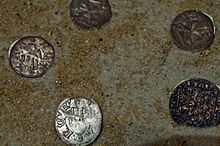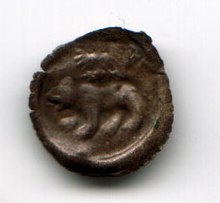Lighter (coin)
A Heller or Haller , abbreviated hlr. , is an earlier German coin with a value of half a pfennig , named after the city (Schwäbisch) Hall , in Latin denarius hallensis or hallensis denarius . They were first mentioned in a document in 1200 or 1208, according to Reiner as early as 1189. Double-sided silver pfennigs (Häller pfennige), called "Händelheller", were minted because they mostly depicted a hand. The Heller gradually deteriorated to the point where they were no longer silver coins. A distinction was made between white, red and black lighters; 576 Heller were counted on the Reichstaler . After World War II, Heller was only available in Czechoslovakia and Hungary .
The Heller also existed as a silver weight of 1/512 of the weight mark .
Germany
In Swabia , the Heller originally corresponded to the Pfennig , so that 240 Hellers made one pound . According to an imperial edict of 1385, however, the value of the Heller was halved, resulting in the value 8 Heller = 4 Pfennig = 1 Kreuzer and 4 Kreuzer = 1 Batzen .
In the then Bohemian Upper Lusatia , the cities of Bautzen and Görlitz had the right to mint. In the 15th century they minted alternately every year. The Görlitzer Heller (Katterfinken) was a coin whose silver content fell more and more in later minting years.
As part of the silver Grosch currency Wettins was, for example, about 1490: 24 = 12 Heller Pfennig = 2 half sword dime = 1 Spitz dime = 1 Bart dime or Zinsgroschen . The Heller were Hohlheller, similar to the Thuringian hollow pfennigs.
In the Electorate of Hesse , the silver groschen was divided into 12 hellers, so that the heller was equal to the Prussian pfennig . Three-lighters were copper 1½-pfennig pieces that were minted in the Saxon-Gotha region.
With the conversion to the unified Reich currency Mark and Pfennig through the Coin Act of July 9, 1873, the Heller disappeared like all other old currency units (except for the simple Vereinstaler , which was in circulation until 1907). Only the last Bavarian hellers of the former association's guilder currency were still valid for some time after 1878 as ½ pfennigs of the new gold mark rich currency in Bavaria.
Switzerland
In the late Middle Ages, the Haller was the smallest coin unit in the area of the Swiss Confederation and was equivalent to half a pfennig . The first Hallers from southern Germany came to northern Switzerland in the 1320s, where they replaced the production of small, one-sided pennies, which were now known as Hallers.
This Haller established itself as a basic unit in the Zurich city-state and in the prince abbey of St. Gallen from 1370. As the name of an increasingly devalued coin, the Haller existed nominally until the end of the 18th century.
Austria
In Austria-Hungary's gold currency (mid-19th to early 20th century) the heller was the hundredth part of a crown . The names still used in the Czech Republic, Slovakia and Hungary are derived from this tradition.
Czechoslovakia, Czech Republic, Slovakia
The Czechoslovak , Slovak and Czech crowns were divided into 100 hellers. The corresponding translation in Czech is haléř or halíř, plural haléře, halíře, haléřů, halířů , etc., in Slovak halier, plural haliere or halierov .
The coins with the Heller values have been gradually taken out of circulation in the Czech Republic since 1993. In Slovakia, the Heller coins of Czechoslovakia were initially used, in 1993 own coins were minted, but only the values 10, 20 (valid until 2003) and 50 Heller, which also became invalid with the introduction of the Euro in 2008.
Hungary
The Hungarian fillér , the small currency unit for the forint , is also derived from the word Heller .
German East Africa
The Heller experienced a temporary resurrection in German East Africa . From 1904 to 1918 the rupee was divided into 100 hellers instead of the previously common 64 pesa . Coins of ½, 1, 5, 10 and 20 hellers were minted.
Cultural reference
A Heller und ein Batzen is a well-known student and soldiersongby Albert von Schlippenbach (text) and Franz Kugler (music).
The saying "That is not worth a red penny" goes back to the low value of the penny and means that something is worthless. Compare also “settle a debt on penny and penny”, “lose your last penny”, “have no red penny”.
The Last Heller car park is located north of the Wünnenberg-Haaren junction on the A 33 .
See also
literature
- Benedikt Zäch: Haller [Heller]. In: Historical Lexicon of Switzerland .
- 1 lighter . In: German Legal Dictionary , Volume V Sp. 704–707.
- Brighter . In: Swabian dictionary . Volume III Col. 1409-1411
- Haller II . In: Schweizerisches Idiotikon , Volume II, Sp. 1130 f.
Web links
Notes and individual references
- ^ Benedikt Zäch: Haller [Heller]. In: Historical Lexicon of Switzerland .
- ^ Gebhard Mehring: Scripture and literature . Chapter III, p. 38 ( Wikisource )
- ↑ Helmut Kahnt: Das große Münzlexikon von A to Z. , H. Gietl Verlag, Regenstauf 2005, p. 188
- ↑ Reiner Hausherr (ed.): The time of the Staufer. History - art - culture. Volume 1: Catalog. Württembergisches Landesmuseum, Stuttgart 1977, p. 158.
- ↑ For further details on the mutual relationship between the different types of coins, see the relevant article in the Swabian dictionary .
- ↑ For an illustration of Thuringian hollow pennies see the article " Mint Langensalza ".
- ↑ Ordinance 101/1993 Coll. (Czech), accessed on March 17, 2019
- ↑ See the respective articles in the Swabian dictionary and in the Swiss Idiotikon for the eloquent use of language in Swabian and Swiss German .





